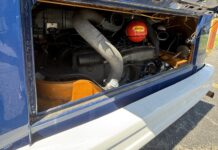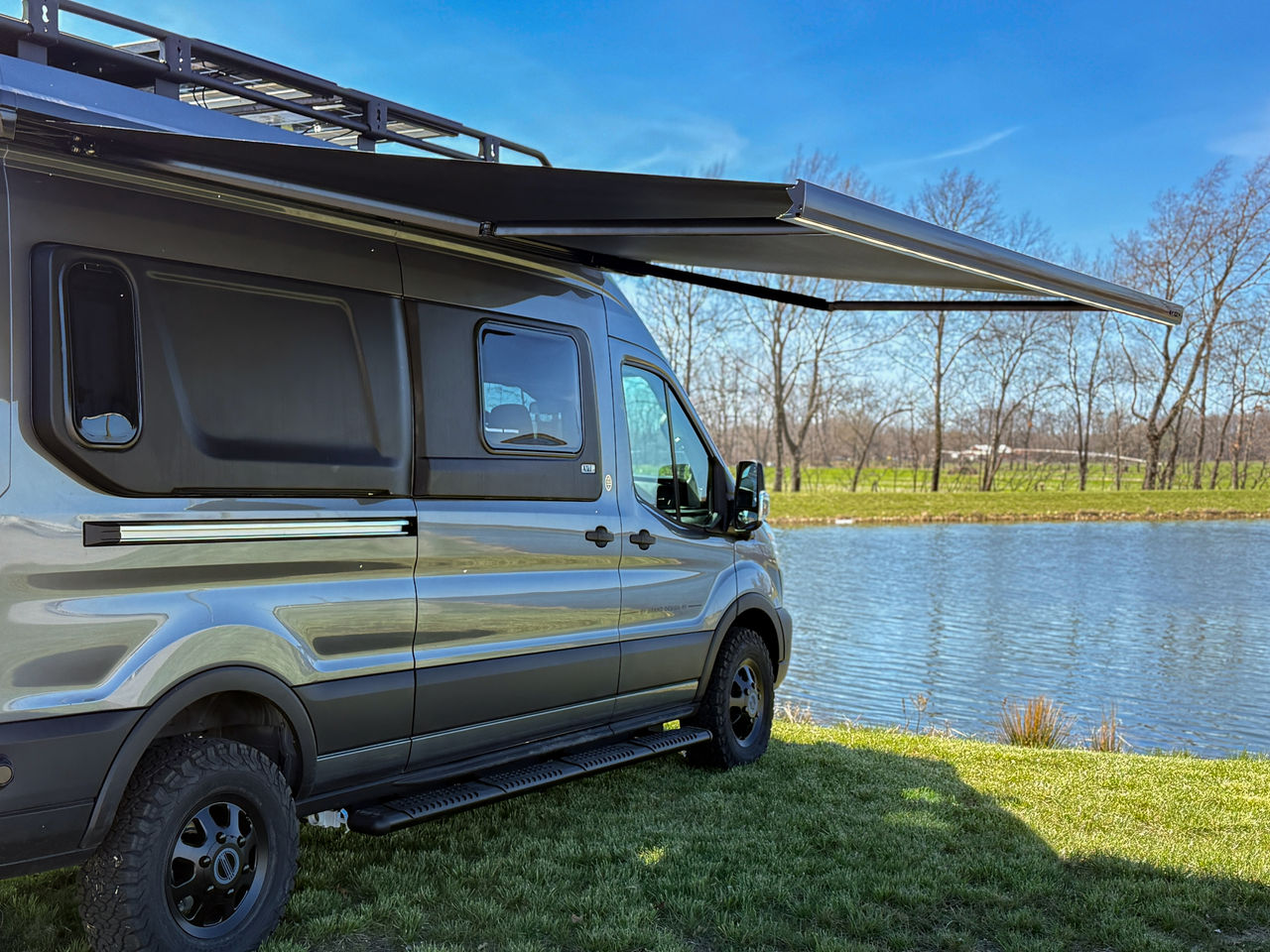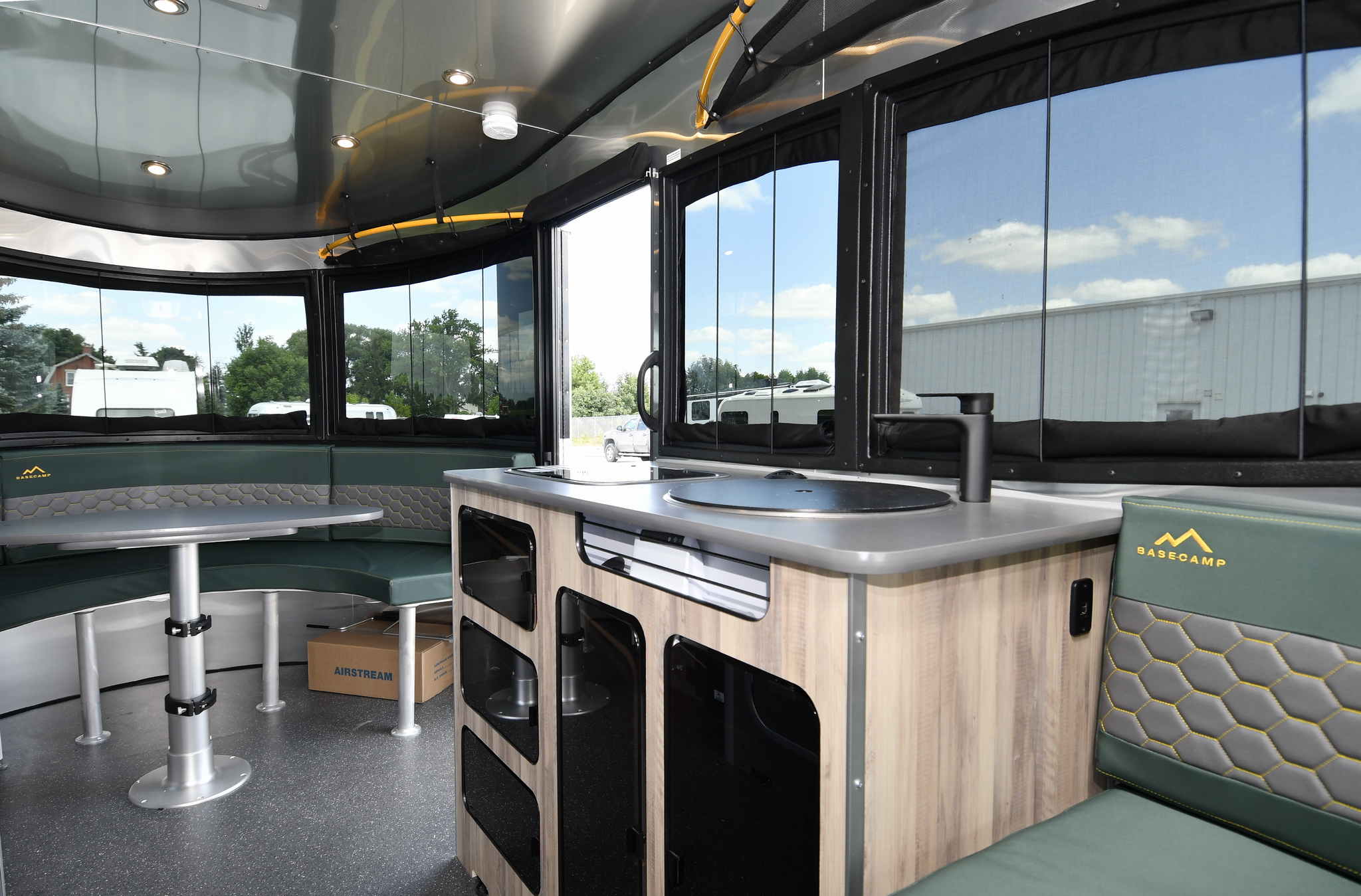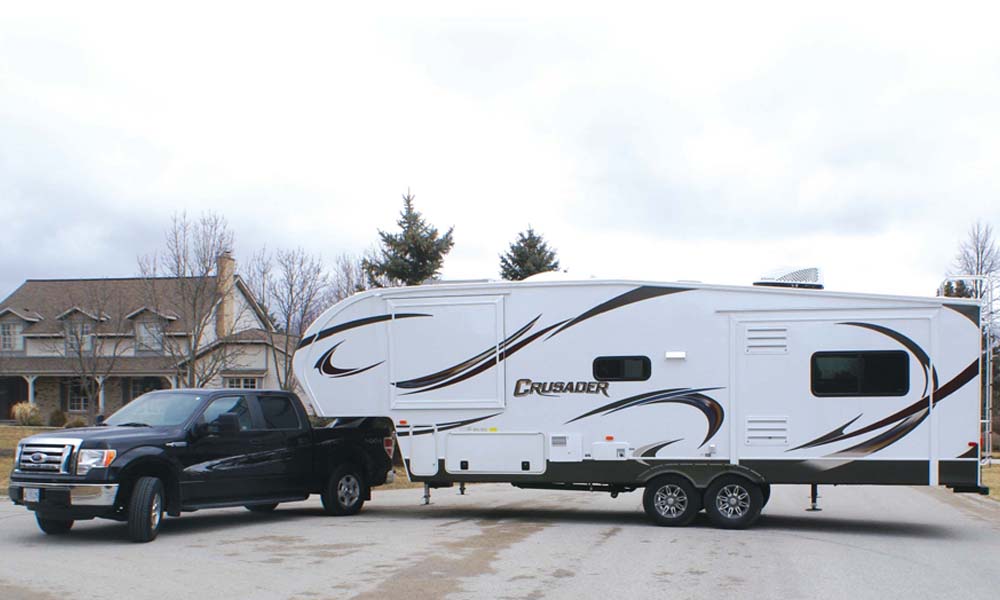By Andy Thomson
When RV’ers are considering a fifth wheel trailer they often ask if it will feel more stable on the road than a travel trailer or a motorhome. Fifth wheels are very stable on a highway and are rarely affected by cross winds or passing trucks. But when you look at a fifth wheel’s design, it would be easy to wonder how they could be stable at all.
The centre of gravity of a fifth wheel is very high, the sidewall area to catch cross winds is massive, most units have basic leaf spring suspensions, while only a few have shock absorbers. The fifth wheel hitch is not complicated. It consists of a simple pivot point that is approximately four feet above the ground, sitting over a basic live axle truck suspension.
Swivel pin boxes allow an impressive turn radius of 90 degrees, but some stability at highway speeds is lost.
Compared with travel trailers, which can have a very low centre of gravity and a pivot point much closer to the ground (with weight distribution and sway controls), there is no contest between the two. When we do slalom and lane change tests, it’s obvious travel trailers handle much better. For example, a good handling travel trailer and tow vehicle can run through a 100-foot slalom close to 80 km/h. With a fifth wheel, the tires start leaving the road at 60 km/h. So, if I find myself in a situation where I need to manoeuver quickly to avoid an accident, I will take a properly set up travel trailer any time.
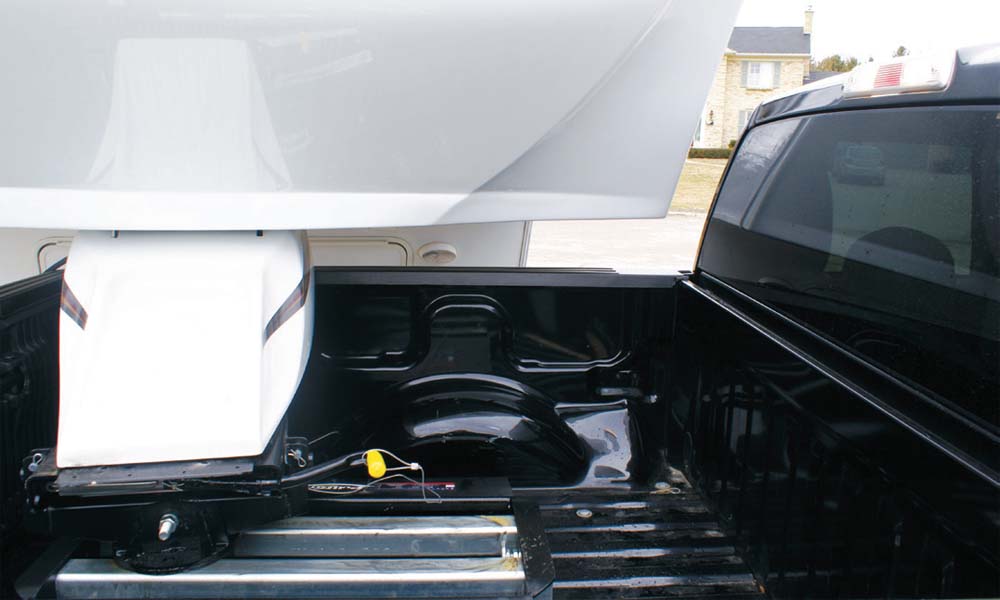
But fifth wheels do have their merits. Going straight down the highway on a windy day, it’s hard to match the driving ease of a fifth wheel in tow. This is due to one key advantage. Of all the measurements we conduct when assessing a tow vehicle for a trailer, a key element we have to consider is the amount of rear overhang. We look at the overhang as a percentage of the wheelbase. For instance, if the vehicle has a 100-inch wheelbase with 40 inches of rear overhang, the overhang is 40 percent of the wheel base (which would not be ideal). The best vehicles are around 30 percent.
But, with a fifth wheel, the overhang is 0 percent of the wheelbase. From a driving perspective, this trumps most other factors I previously mentioned about fifth wheels. Even when making an emergency manoeuver, it’s easy to drive up to the point where the fifth wheel’s centre of gravity becomes the issue. In the slalom, I have had the wheels of a fifth wheel come a couple of feet off the ground and it felt completely stable in the cab. The only thing that made me realize that the wheels were off the ground was a quick glance in the side-view mirror.
Historically, a factor that contributes greatly to the stability of a fifth wheel is the pin or hitch weight was always a higher percentage of the total trailer weight – usually 20 percent. On a travel trailer, it’s normally 10 to 15 percent. This allowed the fifth wheel to have a longer distance from the pivot point to the axles, which makes any trailer more stable. For example a transport trailer with tandem wheels almost at the back of the trailer carries close to 50 percent of its weight on the tractor.
Swivel pin boxes basically offers users of fifth wheels the same turning characteristics of a travel trailer. But if you turn too sharp, the fifth wheel will run into the cab of the truck, causing damage to both vehicles.
The Pull Rite automatic sliding hitch.
Today, many fifth wheels are geared to tow with a half-ton, which means the loaded for travel pin weight needs to be less than 1,500 to 1,700 pounds. On many of these fifth wheels, the pin weight is 12 to 14 percent rather than 20 percent. The first time we had one of these lighter pin weight fifth wheels, I was quite concerned about what effect it might have on stability. On the lot we had two 10,000 pound fifths of the same brand and size – the only difference between the two models were the interior layouts. One unit had 1,100 pounds of pin weight and the other had 1,780 pounds.
Towing them back to back in heavy winds on the same truck and running them through the same handling course, I could not perceive any difference in handling. In theory, there should have been. I think the handling limitations imposed by the centre of gravity come into play long before the difference in the pin weight.
When fifth wheels were introduced on the market, all trucks had eight-foot boxes with the rear axle being 54 inches from the back of the cab. This allowed the eight-foot wide fifth wheel to make a turn 90 degrees to the truck for manoeuvering. Today, most trucks have a five-foot, six-inch or six-foot, six inch box with the axle being 30 to 40 inches behind the cab. Thus, if you turn too sharp, the fifth wheel will run into the cab of the truck, causing damage to both vehicles.
The first solution to this problem was the introduction of sliding hitches, which manually slide the pin position behind the rear axle to allow for tighter manoeuvring at low speeds. These proved effective and are still often used. The benefit is that a short box with a sliding hitch is dramatically more manoeuvrable than a long box. I can park a 35-foot fifth wheel trailer in a tight campsite with a short box a lot easier than with a 28-foot fifth wheel with a long box.
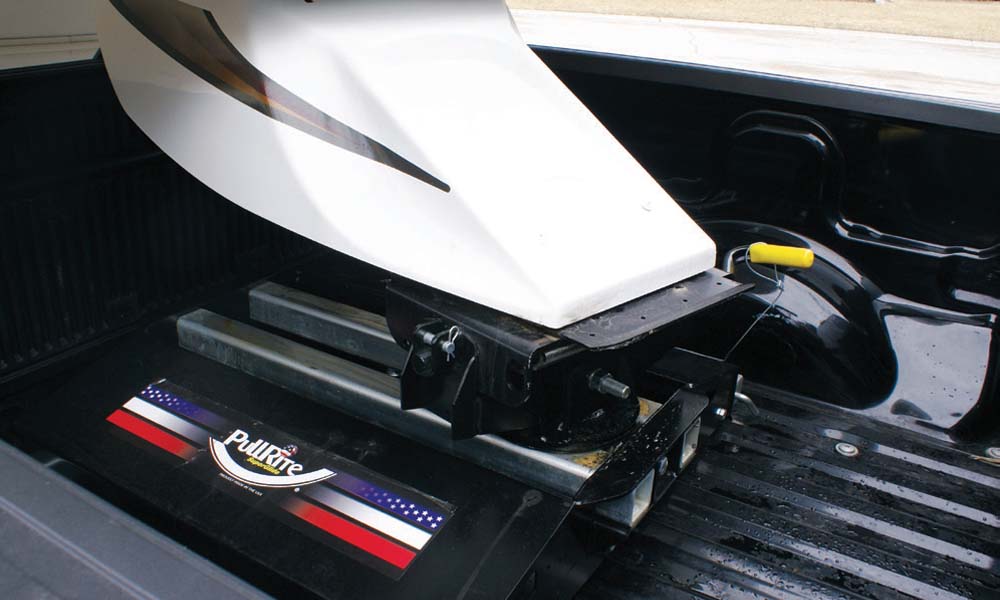
About 15 years ago Pull Rite pioneered the automatic sliding hitch and Demco now makes one as well. These hitches handle like a conventional fifth wheel hitch at highway speed, but automatically slide rearward to allow for easier manoeuvring. The down side is they are $800 to $1,500 more expensive than a fixed or manual sliding hitch of similar quality. Then again you only have to forget to move a manual slider once and you will have saved the extra cost.
A few years ago a swivelling pin box was introduced on the market, which features a fixed hitch situated over the axle. The pin box doesn’t pivot in the hitch, but rather is locked into the truck portion. A 20-inch bearing is built into the pin box located behind the axle where the trailer turns. While it allows an impressive 90-degree turn with the truck, some stability on the highway is lost. Though the pin weight of the fifth wheel is still placed directly over the axle the side to side pivot point is 20” behind the axle or to put it another way your truck now has a rear overhang equal to 15% of the wheelbase. Ultimately you wind up with the disadvantages of a fifth wheel and disadvantages of a travel trailers without the benefit of weight distribution or sway control.
When the swivelling pin box was introduced on the market, I asked the developer what kind of testing was done to determine how much stability is lost. The developer said there wasn’t any loss. I said there had to be and the conversation went downhill from there. It never concerned me a great deal as the product was rarely seen. But now I am seeing some manufacturers offering it as an option and doubt they understand how handling is affected with a swivelling pin box.
Recently, we tested a swivelling pin box to see how much difference 20 inches of overhang really made. We rigged the pin box so we could switch between a sliding hitch and a swivelling pin box on the same trailer-truck combination.
On our test day, which consisted of light winds and a smooth road, it was difficult to tell whether the hitch was pivoting over the axle or 20 inches behind. However, when the cross winds kicked up or when a truck passed us, you could feel the trailer pushing the truck around. It was less than I expected, but it was certainly there.
During an evasive manoeuver, such as a sudden lane change, we were totally stable with 0 percent overhang. However, the trailer became much more of a handful with 15 percent overhang.
At 0 percent, the trailer immediately straightened out after a fast lane change, but with the 15 percent overhang there were a couple of extra swings from side to side. My concern is that this design of hitch, combined with the lighter pin weights, could result in an unstable situation.
There are some nice features with the pivoting pin box. It is simpler than an automatic slider and easier to connect. Just be aware that you may be trading off some safety and stability to get those features.








